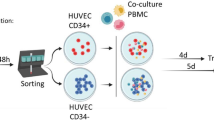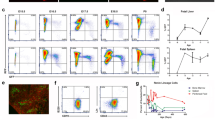Abstract
BECAUSE of its membranous nature, the greater omentum of the mouse is a convenient tissue for serial studies of the cellular events in an immune response. Using mice it was found that after intraperitoneal stimulation with sheep erythrocytes the number of milk spots on the omentum was markedly increased1. These milk spots represent accumulations of varying numbers of lymphoid cells and macrophages. By a modification of the local haemolysis in gel technique it was shown that large milk spots produced haemolytic antibodies against sheep erythrocytes1. After repeated stimulation, clusters of plasma cells could be identified in the vicinity of relatively large milk spots. In some experiments the omenta were explanted into tissue culture, and continued to produce antibody in vitro for more than 60 days2.
This is a preview of subscription content, access via your institution
Access options
Subscribe to this journal
Receive 51 print issues and online access
$199.00 per year
only $3.90 per issue
Buy this article
- Purchase on Springer Link
- Instant access to full article PDF
Prices may be subject to local taxes which are calculated during checkout
Similar content being viewed by others
References
Kaboth, U., Ax, W., and Fischer, H., Z. Naturforschg., 21b, 789 (1966).
Ax, W., Kaboth, U., and Fischer, H., Z. Naturforschg., 21b, 782 (1966).
Malchow, H., Ax, W., and Fischer, H., Z. Naturforschg., 24b, 61 (1969).
Cohen, S., McCluskey, R. T., and Benacerraf, B., J. Immunol., 98, 269 (1967).
Hess, M. W., Experimental Thymectomy (Springer, Berlin–Heidelberg–New York, 1968).
Heilmeyer, L., Kasemir, H., and Kerp, L., German Medical Monthly, 13, 441 (1968).
Davies, A. J. S., Leuchars, E., Wallis, V., Marchant, R., and Elliott, E. V., Transplantation, 5, 222 (1967).
Mitchell, G. F., and Miller, J. F. A. P., Pros. US Nat. Acad. Sci., 59, 296 (1968).
Nossal, G. J. V., Cunningham, A., Mitchell, G. F., and Miller, J. F. A. P., J. Exp. Med., 128, 839 (1968).
Miller, J. F. A. P., and Mitchell, G. F., J. Exp. Med., 128, 801 (1968).
Davies, A. J. S., Leuchars, E., Wallis, V., and Koller, P. C., Transplantation, 4, 438 (1966).
Miller, J. F. A. P., Brit. J. Cancer, 14, 93 (1960).
Taylor, R. B., and Wortis, H. H., Nature, 220, 927 (1968).
Author information
Authors and Affiliations
Rights and permissions
About this article
Cite this article
KRÜSMANN, W., KASEMIR, H. & FISCHER, H. Thymus Dependent Mesothelial Proliferation after Antigenic Stimulation. Nature 222, 1195–1196 (1969). https://doi.org/10.1038/2221195a0
Received:
Issue Date:
DOI: https://doi.org/10.1038/2221195a0
This article is cited by
-
Die Immunfabrik
Klinische Wochenschrift (1969)
Comments
By submitting a comment you agree to abide by our Terms and Community Guidelines. If you find something abusive or that does not comply with our terms or guidelines please flag it as inappropriate.



